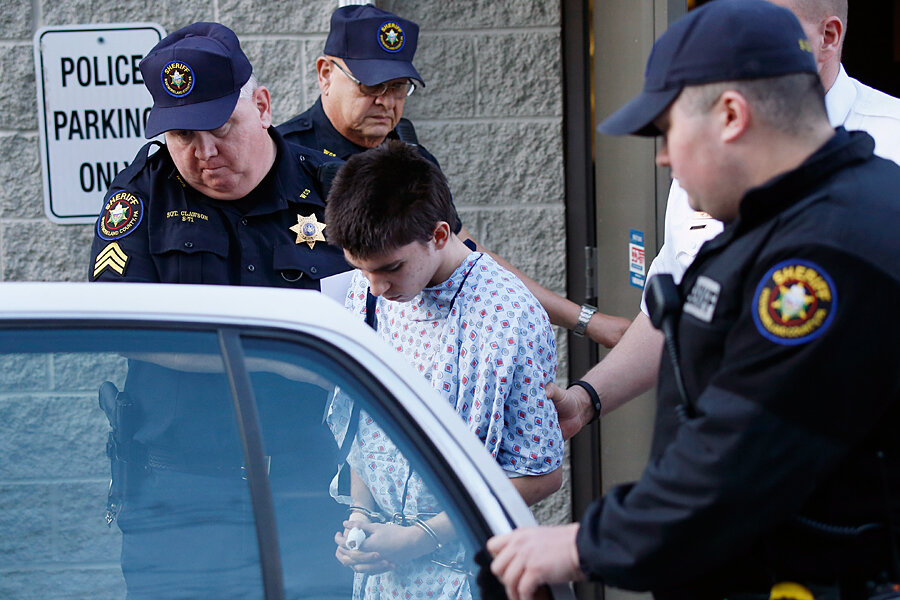School stabbing: Were warning signs missed?
Loading...
Was Alex Hribal a quiet, well-liked kid with nothing in his past that could foreshadow the stabbing rampage he’s accused of carrying out at his high school? Or did he have enough conflict in his life to give signs that something ominous was brewing?
Various reports are emerging one day into the search for answers after Franklin Regional Senior High School in Murrysville, Pa., became the latest school to suffer a mass attack on its students.
Alex, 16, has been charged with four counts of attempted homicide, 21 counts of aggravated assault, and one count of possession of a weapon at school. He’s being held without bail and will have a preliminary hearing April 30.
“He’s a typical young kid.... All the students liked him. He wasn’t a loner,” his attorney, Patrick Thomassey, told CNN. Alex is remorseful, said Mr. Thomassey, who is trying to get the matter moved to juvenile court.
At least one source contradicts that view, however. Alex wasn’t “a real well-liked kid,” a 2010 graduate of Franklin, whose sister still attends the school and witnessed the stabbings, told ABC News. Alex had previously made some threats, said the source, who was not named by ABC.
Investigators are checking into the possibility that a threatening phone call between Alex and another student occurred the night before the stabbing, Murrysville Police Chief Thomas Seefeld said, though he didn’t specify which student might have made the call. Investigators have also taken Alex’s home computer and said they don’t believe he had a cellphone.
District attorney John Peck said at a hearing Wednesday that Alex made comments after he was taken into custody suggesting he wanted to die.
If he were indeed suicidal and/or threatened others, it would fit a pattern common to other mass attacks at schools.
“All of these kids display warning signs,” says Phil Chalmers, author of “Inside the Mind of a Teen Killer,” based on interviews with more than 200 teens who committed school shootings or other killings.
The top elements most common among teen killers, he says, are instability at home or at school (bullying, for instance); an obsession with violent games or other entertainment; being suicidal; and using drugs or alcohol or being on medication. And typically something happens to trigger the attack, such as a breakup.
Whatever the background leading up to it, the nature of the alleged crime in Murrysville indicates “the level of disturbance is pretty high,” says Jennifer Powell-Lunder, a clinical psychologist in Westchester County, N.Y., and co-author of “Teenage as a Second Language.”
“This crime is very personal. Stabbing somebody is not an easy crime to commit,” she says, noting it requires closer contact with the victims than does shooting a gun.
If it turns out that Alex made threats and students didn’t believe they were serious enough to report, that could stem from adolescents’ “belief that bad things happen to other people,” Dr. Powell-Lunder says.
“The answer is to provide continuous education.... Every school should have in place a protocol for the kids ... that if they hear of anything harmful, their responsibility is to pass it on to an adult,” Powell-Lunder says. It’s important to ensure confidentiality, she says, since adolescents tend to fear embarrassment above all else if, say, they point a finger and it turns out not to be a real threat.
Generally, schools have gotten better in recent years at developing threat assessment teams, bringing together school staff, mental health professionals, and law enforcement to sort through various reports that may come in from students or other concerned parties, says Ronald Stephens, executive director of the National School Safety Center in Westlake Village, Calif.
The media can also play a better role in helping people understand what signs to take seriously, suggests Ron Avi Astor, a school violence expert and professor of social work and education at the University of Southern California in Los Angeles. The media tend to tell a similar narrative each time, with witnesses in the immediate aftermath saying the attacker was a quiet kid and no one could have seen it coming, only to later have more details emerge about the attacker’s past. Or they seize on one component such as bullying or mental health.
“The public never really gets to see the multiplicity of issues ... that tend to be there when you look back,” he says.
But over time, more teens have been taught to recognize and report troubling signs among their peers, and it’s hard to know from the few examples that become public how many other incidents of violence have been prevented by their courageous willingness to report, Professor Astor says. “There’s probably thousands of them, and that needs to be revealed.”
In Murrysville and across America, praise has flowed for the swift and selfless acts of many people who helped bring Alex into custody and preserve the lives of those he has been charged with injuring.
“There are a number of heroes in this day,” Pennsylvania Gov. Tom Corbett (R) said at a press conference Wednesday, just a few hours before a half-dozen churches hosted vigils and prayer services for a shaken community.
• Material from the Associated Press was used in this report.






